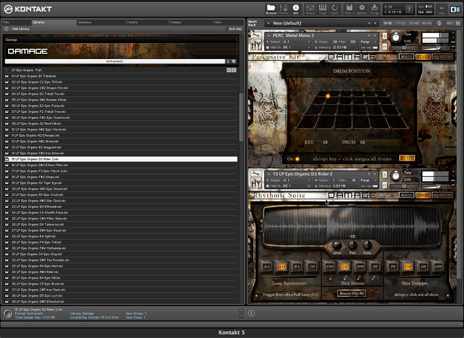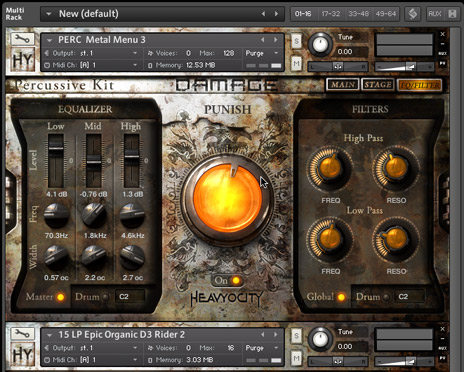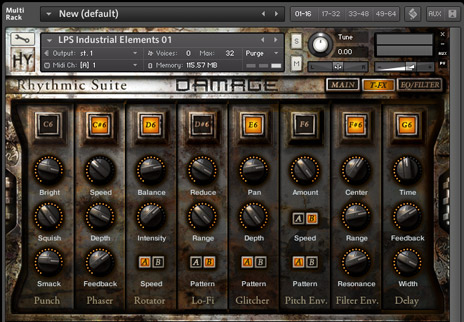Native Instruments Heavyocity Damage (KONTAKT)
Damage, as its name suggests, is a library of percussive hits and loops
with industrial carnage at its core. Shipped in boxed form on two DVDs,
it's released as a collaborative effort between Native Instruments and
Heavyocity. It is compatible with the former's Kontakt instrument both
in "full" form, or for the free-to-download Kontakt Player. The library,
once installed and unpacked, provides you with 30GB of content, with
pre-made loops rubbing shoulders with individual hits layered up in
construction kits. However, rather than just being a playback device for
the samples and loops, the way Damage is organized allows for huge
modification of the sounds and myriad opportunities to personalize the
library's content.
Damage's sounds have all been recorded
specifically for this library and I can only imagine it was enormous fun
to put together. Among the sound sources are cars and machines being
beaten to death with sledgehammers, machines grinding into one another
to the point of destruction, as well as a collection of more traditional
percussion instruments. These have all been bound up into Loop
Menus—groups of matched sounds which work well within a particular
genre, Single Loops—individual loops over which you have greater levels
of control—and Construction Kits of individual hits. There are 58 kits,
which draw on a bank of 200 sound sources recorded into 500 single shot
elements.
The true power of this library comes to the fore when
you begin exploring the options provided by NI/Heavyocity's GUI. The
options change depending on which type of loop or kit you're working on,
with interface pages, relevant to each, clickable in the top right-hand
corner of the window. Within the Loop Menus, for instance, you'll find a
Main Page, one for T(rigger)-FX and a third for EQ/Filter. On the main
page, you can switch on Master Effects with modules to configure
Distortion, LoFi, Reverb, Delay and Compressor settings on the left and
an Amp ADSR-style envelope on the right.

In the middle, you'll find an Amp Sequencer which provides real-time
"chopping" of loops via trigger keys. By default, there are six banks of
these (labeled A-F) and within each bank, trigger notes A6-C7
super-impose a sliced pattern routed to the Amplifier output for as long
as you hold one of those keys down. The effect is to chop up, slice,
ramp or otherwise warp the playback of a loop's volume, though you can
also "permanently" click one of these trigger keys on or program your
own patterns to enhance the presets.
In the T-FX window,
real-time performance goes up a few more gears. Here you'll find eight
modules of triggerable effects mapped from C6 upwards to produce Punch,
Phaser, Rotator, Lo-Fi, Glitcher, Pitch Envelope, Filter Envelope and
Delay effects which, again, last for as long as you're holding a trigger
key. Each module features rotaries and buttons to allow you to
configure effects and you can hold down as many as you like at once to
trigger your own brand of carnage.

The EQ/Filter page features a prominent amber circle which is a rotary
dial to allow you to increase the "Punish" amount. This provides a
program-specific combination of saturation, distortion and compression
which is globally applied. To the left of this is a 3-band EQ with
tweakable frequency and bandwidth controls, while resonant low and
high-pass filters feature on the right. All three of these modules have
orange LED switches so you only have to enable the ones you want to use.
If you're getting a sense that this is more than just a
library of industrial junk percussion, that feeling grows even stronger
when you load a single loop. This time, as well as having the same
effect options, you can dive in to look at the loop you've loaded and
make slice-by-slice edits of the sounds mapped to your keyboard. So, you
can assign level, pan and tuning offsets to each individual slice, as
well as switch on real-time triggers to Randomize, Freeze and Drop
slices, or use B0 to automatically reverse all samples within a loop.
The construction kits are hugely versatile too. In the main page of
these, you'll be greeted with a Master Mixer of sliders which allows you
to blend between the Close, Room and Hall microphones used to record
the samples. Any of these can be muted or solo'd and, if you know you
don't need one microphone's recordings for your current track, its
samples can be purged to reduce the footprint size of the current
program.

Construction Kits also provide the EQ/Filter module common to the Loops
but the additional page here—Stage—is remarkable. Each sample within a
construction kit can be selected (simply press a key) and it will show
within a 3D sound stage, offering 35 positions. Each of these allows you
to blend stereo (left to right) position with space (front to back), so
each sound within a kit can be placed wherever you like. Rather than
having to create a sense of space by loading multiple kits and panning
and reverberating huge collections of samples, you can do this within a
single kit.
Damage is a bombastic library which will
immediately be snapped up by sound designers and those working in
composition for picture. In fact, you can expect this library to become
the go-to one for action chase sequences and glitchy sci-fi textures for
the next few months. However, as it's so configurable, it should prove
an invaluable resource for producers of all kinds of music, with the
individual hits slotting beautifully into dance records, pop productions
and plenty of other genres too. It isn't cheap but it's genuinely
thrilling.
Download (
Only for VIP members)
http://vstclub.com/forum/28-74288-1
 Home
Home  Registration
Registration Sign In
Sign In
 Home
Home  Registration
Registration Sign In
Sign In

